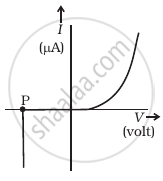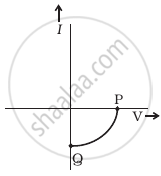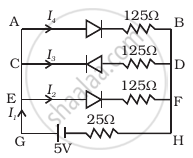Advertisements
Advertisements
Question
 (a) |
 (b) |
- Name the type of a diode whose characteristics are shown in figure (A) and figure (B).
- What does the point P in figure (A) represent?
- What does the points P and Q in figure (B) represent?
Solution
- Figure (a) represents the characteristics of the Zener diode and curve (b) is of the solar cell.
- In figure (a), point P represents Zener breakdown voltage.
- In figure (b), point Q represents zero voltage and negative current. This means the light falling on the solar cell with at least a minimum threshold frequency gives the current in opposite direction to that due to a battery connected to solar cell. But for point Q the battery is short-circuited. Hence it represents the short circuit current. And the point Pin fig. (b) represents some open circuit, the voltage on solar cell with zero current through solar cell.
It means, there is a battery connected to a solar cell which gives rise to the equal and opposite current to that in a solar cell by virtue of light falling on it.
APPEARS IN
RELATED QUESTIONS
Explain the working of P-N junction diode in forward and reverse biased mode.
What causes the setting up of high electric field even for small reverse bias voltage across the diode?
Draw its I – V characteristics of photodiode
With reference to semi-conductors answer the following :
(i) What is the change in the resistance of the semi-conductor with increase in temperature ?
(ii) Name the majority charge carriers in n-type semi-conductor.
(iii) What is meant by doping ?
A plate current of 10 mA is obtained when 60 volts are applied across a diode tube. Assuming the Langmuir-Child relation \[i_p \infty V_p^{3/2}\] to hold, find the dynamic resistance rp in this operating condition.
What are the applications of p - n Junction diode?
Of the diodes shown in the following diagrams, which one is reverse biased?
Figure shows the transfer characteristics of a base biased CE transistor. Which of the following statements are true?

At Vi = 0.4 V, transistor is in active state.
At Vi = 1 V, it can be used as an amplifier.
At Vi = 0.5 V, it can be used as a switch turned off.
At Vi = 2.5 V, it can be used as a switch turned on.
If each diode in figure has a forward bias resistance of 25 Ω and infinite resistance in reverse bias, what will be the values of the current I1, I2, I3 and I4?

Write the property of a junction diode which makes it suitable for rectification of ac voltages.
